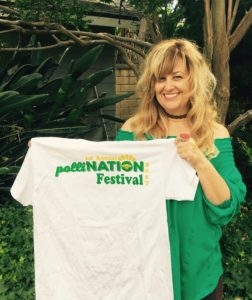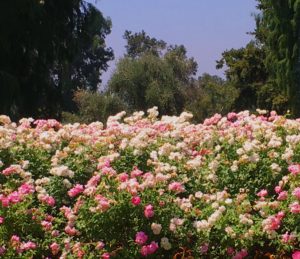Who would have thought that one could draw a connection between the world of *aromatherapy and chemical ecology1. To communicate, species across the five kingdoms (Animalia, Plantae, Fungi, Protista and Monera) use some of the air-borne chemicals that make up essential oils, which are used in aromatherapy. As a chemical ecologist and a certified and registered aromatherapist, I have taught the public about these relationships for years.

Kelly gave a talk on this subject titled the ‘Language of Fragrance in Pollination’ at the 2017 PolliNATION Festival.
This report will reveal examples, and some therapeutic properties of essential oils which contain the same chemical constituents that make up these fragrant bouquets which science has shown to function in bee pollination. Numerous behaviors (e.g. attracting a mate and repelling a predator) mediated by bouquets of air-borne chemicals are also found in essential oils2.
FACT: Responsible for about $20 billion in U.S. crop production, honeybees pollinate more than any other insect pollinator.
Pollination is the transfer of pollen to meditate fertilization. Flowers send out air-borne chemicals to attract pollinators, and in return for helping with their fertilization, they offer rewards such as, pollen, lipids, and/or essential oils. This relationship is what 90% of the world’s food depends upon.
FACT: Olfactory cues provide more and complex information to insect pollinators than visual cues.
Honeybees use approximately 170 olfactory receptors to discriminate among hundreds of air-borne chemicals with precision based on the odorants’ scent intensity, concentration ratios, carbon chain length, and location and number of functional groups. This is particularly impressive given that no two floral scents are exactly the same, and can change because of age, temperature, genetics, and light intensity. Let’s just say that bees excel in chemistry!
FACT: Bees have to detect, process and learn many complex floral scents from the environment on a daily basis.
Honeybee foraging behavior through olfactory cues is vital to forming long-term memories. For example, bees learn, within the hive, relevant information about the odours and foods they will encounter during their future foraging bouts. This scented information comes through floral scents, pollen, nectar, or the waggle dance. Also, plant compounds alter pollinator behavior by enhancing their memory of reward. Rewarded with caffeine, which naturally occurs in Citrus spp. and Coffea spp., the memories of honeybees for floral scents increase threefold.
FACT: Air-borne chemicals that make up floral scents convey messages to pollinators.
Flowers communicate creatively with pollinators. Air-borne chemicals can trigger landing on flowers, play an important role in long-range orientation, nest provisioning, elicit feeding, and control the number of pollinator visits. Some orchids produce air-borne chemicals that mimic the female bee sex pheromone3 to lure pollinators. A successful ruse: yet the orchid still gets pollinated by the male who picks up pollen when landing on the flower! Orchids are deceitful. One-third of the world’s approximately 30,000 orchid species do not offer rewards of nectar and pollen.
FACT: Humans and bees use extracts of flowers to attract mates.
While both bees and humans reap benefits from the essential oils of flowers, humans experience therapeutic benefits, and bees experience successful pollination through the chemical constituents of essential oils also extracted from seeds, wood, resin, leaves, rhizomes, and roots such as the chemical constituents below.
Geraniol is one of the main constituents in the Nasanov pheromone. Worker bees release Nasanov to orient returning forager bees back to the colony. Pollinators use it to navigate and search for food. Rose (Rosa spp.) [it takes about 120 lbs. of rose petals to make 1oz. of essential oil] and Geranium (Pelargonium graveolens) essential oils contain this air-borne constituent. Rose essential oil contains anti-inflammatory, immune stimulant, and aphrodisiac properties, whereas Geranium oil supports the reduction of symptoms associated with rheumatism, stress, and PMS.
-See below for a recipe to make your own rose-infused honey!-
Citral is a very important constituent for the attraction of bees to orchards and to alfalfa crops. Lemongrass (Cymbopogon spp.) essential oil contains citral. This oil has tonic, and diuretic properties, and helps to enhance concentration.
Linalool helps worker bees with orientation, and to successfully navigate and search for food. Bumble bees also use it to distinguish nectar-rich flowers from depleted flowers. Lavender (Lavandula angustifolia) essential oil, which contains the constituent linalool, has been scientifically shown to reduce anxiety and kill bacteria, and help combat muscle pain.
Anethole instructs nestmates where to find food. Anise (Pimpinella anisum) and Fennel (Foeniculum vulgare) essential oils contain the anethole constituent. Practitioners of a variety of disciplines report that Anise essential oil has carminative, sedative and analgesic properties; and Fennel essential oil helps to reduce the symptoms of a hangover, and contains anti-spasmodic, and immune stimulant properties.
Carvacrol attracts pollinators from a distance, and guides them inside flowers at close range. Oregano (Origanum vulgare) essential oil, has the carvacrol constituent, which effectively combats fungus.
Zingiberene, is the key attractant of the Cistus albidus plant. Ginger (Zingiber officinale) essential oil contains zingiberene which helps combat digestive issues, and reduce travel sickness.
Limonene is an important attractant used by Hoplitis adunca to find flowers of Echium spp. Sweet orange (Citrus sinensis) and Lime (Citrus x aurantifolia) essential oils contain the constituent limonene. Sweet orange essential oil has scientifically been shown to contain anti-fungal, anti-inflammatory, and anti-depressant properties. Lime essential oil has decongestant, mucolytic, and anti-coagulant properties.
Eugenol is critical to attracting bees to sweet orange crops, and found in Clove (Syzygium aromaticum) bud essential oil. If you ever get a toothache, or suffer from arthritis, with the help of a certified aromatherapist, Clove oil may be your answer!
FACT: Bees are fundamentally important for successful pollination; declines in populations could have significant economic and environmental implications.
We need to help keep honeybee populations healthy. Evidence shows that components of pesticides, especially those containing neonicotinoids, impair olfactory learning and memory formation in bees. When this occurs, foraging, navigation, orientation and feeding behaviors change and colonies can collapse. Please avoid using pesticides and buying flora with pesticides when possible!
Rose-infused honey
Ingredients
[amazon_textlink asin=’B014V7RSE8′ text=’16 oz. Mason canning jar with lid’ template=’ProductLink’ store=’kablard-20′ marketplace=’US’ link_id=’69f738dd-73f9-11e7-b558-6b6eaef7b046′]
4 cups of [amazon_textlink asin=’B00R53VT1E’ text=’organic **rose petals’ template=’ProductLink’ store=’kablard-20′ marketplace=’US’ link_id=’75e8392e-73fe-11e7-bc6d-5fd00642b757′]
2 cups [amazon_textlink asin=’B01IR6J4CI’ text=’raw honey’ template=’ProductLink’ store=’kablard-20′ marketplace=’US’ link_id=’8cee151a-73fe-11e7-8760-b3e7f1d630a5′] (preferably locally sourced!)
**avoid using rose petals that have been sprayed with pesticides; freshly-harvested petals should be spread out on paper so that insects can easily be spotted and removed; pick the most fragrant roses; rose petals can be fresh or dried; and if harvesting yourself, do so sustainably by only picking up to 1/3 of the plants roses.
Recipe
Fill the jar with rose petals
Add honey to the jar and make sure all rose petals are completely covered
Stir the rose petals and honey to remove air bubbles
Cover the mason jar and make sure the lid is on tight
Let infuse for 2 weeks
Enjoy your rose-infused honey with or without the petals!
*Essential oils should be used with extreme caution! Please seek advice from a certified aromatherapist about how to use essential oils safely, and to determine an individualized treatment plan.
1Chemical ecology – is the study of interactions among and between species, and between species and their environment, that involve specific chemical compounds or groups of chemical compounds known as semiochemicals which mediate many different behaviors.
2Essential oil – a hydrophobic liquid composed of natural plant chemical constituents that have some measurable therapeutic activity validated through research.
3Pheromone – a subclass of a semiochemical used for communication with the same species.
[amazon_link asins=’B006ITP200′ template=’ProductAd’ store=’kablard-20′ marketplace=’US’ link_id=’90dd3460-73ff-11e7-a85b-c33fd9e901d6′]
[amazon_link asins=’B01MQ6C1TT’ template=’ProductAd’ store=’kablard-20′ marketplace=’US’ link_id=’28f00f6f-7401-11e7-a047-117a7f88ec2f’]
[amazon_link asins=’0801476941′ template=’ProductAd’ store=’kablard-20′ marketplace=’US’ link_id=’573d1757-7401-11e7-8dbd-dda74fef6dff’]
[amazon_link asins=’B00K1IUZQK’ template=’ProductAd’ store=’kablard-20′ marketplace=’US’ link_id=’6c1f9dfc-7401-11e7-8949-bfc7ed4da25d’]
[amazon_link asins=’B01IR6IZZA’ template=’ProductCarousel’ store=’kablard-20′ marketplace=’US’ link_id=’9cbc1298-7401-11e7-9b48-295527ea1816′]
[amazon_link asins=’B014V7RSE8′ template=’ProductCarousel’ store=’kablard-20′ marketplace=’US’ link_id=’a65a14e1-7401-11e7-982a-edb415147b62′]
[amazon_link asins=’0931432820′ template=’ProductCarousel’ store=’kablard-20′ marketplace=’US’ link_id=’b032ad7f-7401-11e7-a9cd-c930ab2999e5′]


